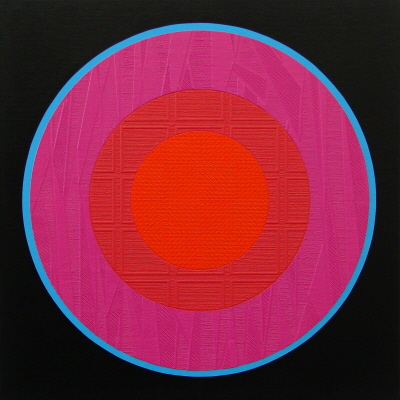
Image:Mater Dei (2010), Acrylic and collaged wallpaper on linen, 59 x 59cm
19th November to 19th December
SUMARRIA LUNN and Art Work Space are pleased to present a solo exhibition of work by David Wightman.
David Wightman builds layers of precision-cut wallpaper shapes to create both abstract and landscape paintings in a method similar to marquetry. Drawing on the tools of postmodern thought including pastiche, hybridity and even parody, he plays with established genres that art criticism has often declared obsolete. As such, his works are rich with wistful suggestion, and confront the struggle of any art to truly represent what it imitates.
Constructed through a systematic but experimental design process, the artist ensures that both his landscapes and abstract ‘targets’ speak of an “obsession with colour”. He establishes the harmony of his non-naturalistic palette through a combination of digital and painted modelli, rendering his paintings a geometric synthesis of contemporary and traditional methods of working. Aside from technique, Wightman’s abstract and landscape works are conceptually comparable: “In both my abstract and landscape paintings, the colours and patterns I choose indicate an aesthetic link between aspirational working class homes and high art. My work is an attempt to reclaim abstraction and landscape on my own terms.”

Image:Lorelei (2010), Acrylic and collaged wallpaper on canvas, 115 x 196cm
Lorelei shows a monotone mountainscape with a lake of bright magenta. Using a direct juxtaposition of hot and cold hues Wightman emphasises the isolation and intimidation of this stone colossus. The absence of colour across the background suggests by proxy the absence of life, and yet the vivid lake attempts to draw the viewer closer, to lure us in. It was on his deathbed in Switzerland that the nineteenth-century Italian painter Giovanni Segantini uttered his final words: “I want to see my mountains.” It is this struggle between the compulsion to personalise, to possess this natural monolith, and our inherent sense of awe which the artist makes manifest. More than this, he subtly undermines the hackneyed pursuit of the ‘ideal landscape’ by exploiting the kitsch connotations of wallpaper, resisting the theoretical loftiness of abstraction – or even Greenbergian aesthetics – to instead progress in the direction of nostalgia and whimsy. The subversion of awe is further compounded in Lorelei’s strict palette and sharp, precision-cut outlines; more archetypal of geometry than geology.
Mater Dei, the Latin translation of ‘Theotokos’ (Mother of God), is one of a number of works inspired by the artist’s keen interest in the interplay between theology and art. “I’m not religious, but I’m interested in continuing, in a secular way, the tradition of theological subjects in painting.” Although this is done obliquely, Wightman is romanced by the idea of his abstract paintings “existing as secular icons.” Mater Dei comprises four painstakingly hand-cut circles, whose independent patterns appear to intertwine such that the piece seems to resist its strict geometric boundaries. Rich with reds and magentas at its core, Mater Dei tricks the eye into perceiving a fluctuating number of layers through the delicate optical blending of its central components. An outline of cool blue concludes the piece, almost ‘locking’ its forms into place and in so doing emphasises the omnipresence of the circle, the perfect shape: a geometric allusion to the Madonna.
Imbuing his works with a sense of intimacy fuelled by references to his own background, Wightman’s paintings are a homage to nostalgia and homeliness. The intensity of glossy colour interrupts the nature of the wallpaper, complicating its reception and elevating it from decorative platform to artistic statement, and yet the inherent ‘kitsch’ connotations cleverly undermine this. As such, Wightman’s works provoke a part tragic, yet darkly humorous, conception of the symbiotic relationship between aspiration and abstraction.





